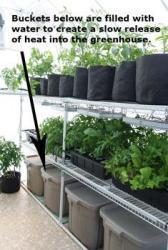http://www.greenhousecatalog.c...
I wondered if this might be a good solution for those of us living in areas with lots of rock (we just can't dig big holes - too much rock):
HERE'S THE SECTION FROM THE ARTICLE:
. Increase thermal mass
Fill large buckets with water to collect heat during the day and slowly release it at night to help keep the greenhouse temperature warmer.
There are several commonly used materials for increasing thermal mass: stone, concrete and water. Gravel makes an excellent flooring for the greenhouse that increases the thermal mass and also allows water to drain. For additional thermal mass, water is an excellent mode of heat storage because it distributes the heat very evenly and releases it slowly. Large containers of water in a greenhouse will radiate heat all night, long after the last flickers of evening light fade. Warmth emitted from solar water containers is a slow, subtle, even heat that helps to maintain even greenhouse temperatures. Note: five gallon plastic buckets or 30 gallon barrels work nicely in a greenhouse (2). Vessels are filled ¾ of the way with water then capped off tightly to prohibit evaporation and humidity. Smaller buckets are easily arranged to create a nice shelf, while large barrels also make nice plant stands. Black plastic works well for storage containers. Black will absorb most of the radiation hitting its surface transferring the heat to the water. Stainless and copper vessels work as well. They will heat much faster and transfer greater heat intensity to the water which absorbs more heat as a result. Metal containers may add undue expense and be difficult to find. I have not tried metal containers, but think it would be interesting to see a side by side test.
3. Use a reflective surface to capture more sun
Directing the most light possible to the thermal mass can significantly increase the heating capacity. Samuel Pierpont Langley, an astrophysicist, in California conducted a series of solar experiments on Mt. Whitney (14,491 ft.) in 1881. He was intrigued by solar energy and wanted to study it in range of temperatures. He climbed the mountain until he found frozen ground. He proceeded to boil water in a copper pot placed on the ground using only pieces of glass (3). Boiling water is not the objective, but concentrating as many rays as possible on the water wall will increase the heat and therefore the length of the effectiveness. Reflective insulation on the North wall will help redirect light from the back of the greenhouse to the thermal mass, as well as create healthier light for plants. Ideally, the only dark surfaces in the greenhouse should be planted containers and water storage. Aluminum foil is excellent for covering dark structures or redirecting light where needed in the greenhouse.
Recently I spoke with a woman who owned one of our greenhouses in Montana. She told me she was able to grow lettuce and other crops in her greenhouse year-round despite the fact the ground was covered in snow. She said her neighbors were amazed but her secret was the snow. The greenhouse was placed in a large field with direct Southern exposure. The snow reflected so much additional light into the greenhouse that she could literally see (and taste) the results. You don't need snow to make this concept work for you. Adding white gravel or plastic outside the greenhouse will also reflect additional light into the structure.

